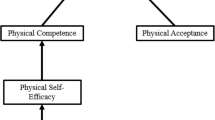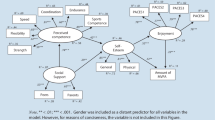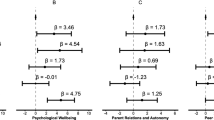Abstract
This study investigated the mediating role of body mass index (BMI) in the relationship between physical activity and body esteem in adolescents. Nine hundred and five Hong Kong Chinese students aged 12–18 years participated in a cross-sectional study in 2007. Students’ BMI was computed as an indicator of their body composition. Their physical activity level and body esteem were examined using the Physical Activity Rating for Children and Youth (PARCY) and Body Esteem Scale (BES), respectively. Structural equation modelling was used to investigate the mediating effects of BMI and physical activity in predicting body esteem, with stratification by sex. The overall fit of the hypothesized models was satisfactory in boys (NFI = 0.94; NNFI = 0.88; CFI = 0.95; RMSEA = 0.07) and girls (NFI = 0.89; NNFI = 0.77; CFI = 0.91; RMSEA = 0.11). When BMI was considered as a mediator, higher physical activity had a significant negative total effect on body esteem in boys, but not in girls. The indirect effect of higher physical activity on body esteem via BMI was positive in boys, but negative in girls.
Conclusions: Regular physical activity may help overweight adolescents, especially boys, improve their body esteem. Kinesiologists and health professionals could explore the use of physical activity prescriptions for weight management, aiming at body esteem improvement in community health programs for adolescents.
What is Known: •Among Western adolescents, negative body esteem is more pervasive in girls than in boys. •There are consistent findings of the association between higher body mass index and lower body esteem in adolescents, but the association between physical activity and body esteem are equivocal. |
What is New: •A negative association between body mass index and body esteem was found in both Hong Kong adolescent boys and girls. •The indirect effect of physical activity on body esteem via body mass index was positive in Hong Kong adolescent boys, but negative in girls. |


Similar content being viewed by others
References
Altintas A, Asci FH, Kin-Isler A, Guven-Karahan B, Kelecek S, Ozkan A, Yilmaz A, Kara FM (2014) The role of physical activity, body mass index and maturity status in body-related perceptions and self-esteem of adolescents. Ann Hum Biol 41:395–402
Bacil ED, Mazzardo Junior O, Rech CR, Legnani RF, de Campos W (2015) Physical activity and biological maturation: a systematic review. Rev Paul Pediatr 33:114–121
Byrne BM (2006) Structural equation modeling with EQS: basic concepts, applications, and programming. Lawrence Erlbaum Associates
Chen H, Jackson T (2009) Predictors of changes in weight esteem among mainland Chinese adolescents: a longitudinal analysis. Dev Psychol 45:1618–1629
Cole TJ, Bellizzi MC, Flegal KM, Dietz WH (2000) Establishing a standard definition for child overweight and obesity worldwide: international survey. BMJ 320:1240–1243
Cortese S, Cuzzolaro M, Maffeis C, Piccolo F, Ferrucci G, Tato L, Pajno-Ferrara F, Dalla Bernardina B (2005) Depressive symptoms and low self-esteem in obese children and adolescents. Minerva Pediatr 57:65–71
Duncan MJ, Al-Nakeeb Y, Nevill AM, Jones MV (2006) Body dissatisfaction, body fat and physical activity in British children. Int J Pediatr Obes 1:89–95
Ekeland E, Heian F, Hagen KB (2005) Can exercise improve self esteem in children and young people? A systematic review of randomised controlled trials. Br J Sports Med 39:792–798
Erermis S, Cetin N, Tamar M, Bukusoglu N, Akdeniz F, Goksen D (2004) Is obesity a risk factor for psychopathology among adolescents? Pediatr Int 46:296–301
French SA, Story M, Perry CL (1995) Self-esteem and obesity in children and adolescents: a literature review. Obes Res 3:479–490
Godin G, Shephard RJ (1985) A simple method to assess exercise behavior in the community. Can J Appl Sport Sci 10:141–146
Griffiths LJ, Parsons TJ, Hill AJ (2010) Self-esteem and quality of life in obese children and adolescents: a systematic review. Int J Pediatr Obes 5:282–304
Gutierrez T, Espinoza P, Penelo E, Mora M, Gonzalez ML, Roses R, Raich RM (2015) Association of biological, psychological and lifestyle risk factors for eating disturbances in adolescents. J Health Psychol 20:839–849
Huang JS, Norman GJ, Zabinski MF, Calfas K, Patrick K (2007) Body image and self-esteem among adolescents undergoing an intervention targeting dietary and physical activity behaviors. J Adolesc Health 40:245–251
Kaminsky LA, Dewey D (2014) The association between body mass index and physical activity, and body image, self esteem and social support in adolescents with type 1 diabetes. Can J Diabetes 38:244–249
Kim O, Kim K (2001) Body weight, self-esteem, and depression in Korean female. Adolescence 36:315–322
Kirkcaldy BD, Shephard RJ, Siefen RG (2002) The relationship between physical activity and self-image and problem behaviour among adolescents. Soc Psychiatry Psychiatr Epidemiol 37:544–550
Kong AP, Choi KC, Li AM, Hui SS, Chan MH, Wing YK, Ma RC, Lam CW, Lau JT, So WY, Ko GT, Chan JC (2010) Association between physical activity and cardiovascular risk in Chinese youth independent of age and pubertal stage. BMC Public Health 10:303
Kristjansson AL, Sigfusdottir ID, Allegrante JP (2010) Health behavior and academic achievement among adolescents: the relative contribution of dietary habits, physical activity, body mass index, and self-esteem. Health Educ Behav 37:51–64
Mak KK, Lai CM (2011) The risks of disordered eating in Hong Kong adolescents. Eat Weight Disord 16:e289–292
Mak KK, Pang JS, Lai CM, Ho RC (2013) Body esteem in Chinese adolescents: effect of gender, age, and weight. J Health Psychol 18:46–54
Makinen M, Lindberg N, Komulainen E, Puukko-Viertomies LR, Aalberg V, Marttunen M (2014) Psychological well-being in adolescents with excess weight. Nord J Psychiatry:1–10
McClure AC, Tanski SE, Kingsbury J, Gerrard M, Sargent JD (2010) Characteristics associated with low self-esteem among US adolescents. Acad Pediatr 10(238–244), e232
Mendelson BK, White DR, Mendelson MJ (1996) Self-esteem and body esteem: effects of gender, age, and weight. J Appl Dev Psychol 17:321–346
Mendelson BK, McLaren L, Gauvin L, Steiger H (2002) The relationship of self-esteem and body esteem in women with and without eating disorders. Int J Eat Disord 31:318–323
Mendelson BK, Mendelson MJ, White DR (2001) Body-esteem scale for adolescents and adults. J Pers Assess 76:90–106
Mendelson BK, White DR (1982) Relation between body-esteem and self-esteem of obese and normal children. Percept Mot Skills 54:899–905
Mendelson BK, White DR, Mendleson MJ (1995) Children’s global self-esteem predicted by body-esteem but not by weight. Percept Mot Skills 80:97–98
Park W, Epstein NB (2013) The longitudinal causal directionality between body image distress and self-esteem among Korean adolescents: the moderating effect of relationships with parents. J Adolesc 36:403–411
Raustorp A, Mattsson E, Svensson K, Stahle A (2006) Physical activity, body composition and physical self-esteem: a 3-year follow-up study among adolescents in Sweden. Scand J Med Sci Sports 16:258–266
Sasai K, Tanaka K, Hishimoto A (2011) Alexithymia and its relationships with eating behavior, self esteem, and body esteem in college women. Kobe J Med Sci 56:E231–238
Schmalz DL, Deane GD, Birch LL, Davison KK (2007) A longitudinal assessment of the links between physical activity and self-esteem in early adolescent non-Hispanic females. J Adolesc Health 41:559–565
Shriver LH, Harrist AW, Page M, Hubbs-Tait L, Moulton M, Topham G (2013) Differences in body esteem by weight status, gender, and physical activity among young elementary school-aged children. Body Image 10:78–84
Sonstroem RJ, Morgan WP (1989) Exercise and self-esteem: rationale and model. Med Sci Sports Exerc 21:329–337
Strauss RS (2000) Childhood obesity and self-esteem. Pediatrics 105, e15
Tiffin PA, Arnott B, Moore HJ, Summerbell CD (2011) Modelling the relationship between obesity and mental health in children and adolescents: findings from the Health Survey for England 2007. Child Adolesc Psychiatry Ment Health 5:31
Waade NR (2004) Exercise improves self-esteem in children and young people. Aust J Physiother 50:117
Wang H, Leung GM, Schooling CM (2015) Life course body mass index and adolescent self-esteem: evidence from Hong Kong’s “Children of 1997” birth cohort. Obesity 23:429–435
Conflict of interest
The authors declare that they have no competing interests.
Authors’ contributions
KKM preformed the data analysis, interpreted the results, and drafted and approved the manuscript. CE, AMM, and CML assisted in the data analysis and interpretation, and reviewed the manuscript. JRD and SYH revised the manuscript.
Author information
Authors and Affiliations
Corresponding author
Additional information
Communicated by Jaan Toelen
Revisions received: 14 May 2015 / 16 June 2015
Rights and permissions
About this article
Cite this article
Mak, KK., Cerin, E., McManus, A.M. et al. Mediating effects of body composition between physical activity and body esteem in Hong Kong adolescents: a structural equation modeling approach. Eur J Pediatr 175, 31–37 (2016). https://doi.org/10.1007/s00431-015-2586-5
Received:
Revised:
Accepted:
Published:
Issue Date:
DOI: https://doi.org/10.1007/s00431-015-2586-5




